Care Advocate
Care Advocate is a Lively™ service where seniors can collaborate with a care team of skilled social workers to create personalized care plans to help them holistically improve their health and well-being. Traditional healthcare models tend to focus on reactive interventions, and we aimed to design proactive personalized care plans tailored to individuals' needs. Using principles of behavior science, we empower seniors to lead fulfilling lives by actively engaging in their wellness journey.
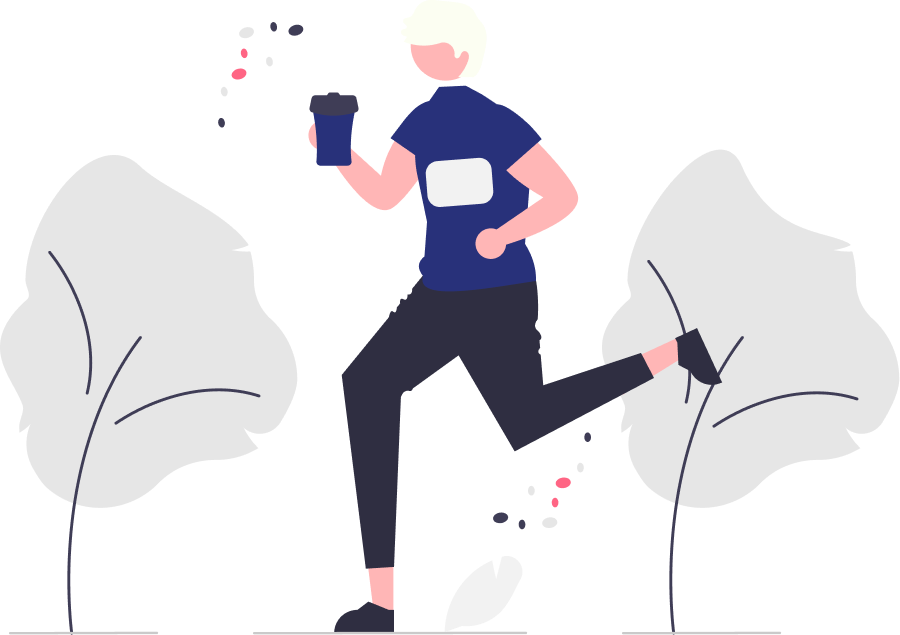
WHAT'D I DO?
Service design, product design
WHAT'D I WORK IN?
Figma, Miro, Ms teams
WHO'D I WORK WITH?
2 other product designers, 1 UX researcher, 1 visual designer, 1 product manager, 1 technical program manager, a team of engineers
WHEN'D I WORK ON THIS?
I worked on the project during my time at Bestbuy Health. This program was a part of the Premium Health & Safety plan package and would be an easy-to-access service where a team of licensed Social Workers (aka Care Agents) provide personal care, expert solutions, and access to trusted resources designed uniquely for the
needs of GenA.
This project adopts a practice-led, research-through-design approach. Patient-centered design techniques, including user journeys, personas, and an experience roadmap, are utilized to understand seniors' challenges, motivations, and preferences better. These artifacts enabled us to empathize with seniors and uncover insights crucial to developing an effective solution.
01
Foundational Research
Research Objective
To uncover insights related to how GenA customers currently handle their health and wellness and to foster meaningful interactions between GenA customers and their Care Agents,
Research Questions
- How do GenA customers manage their health and well-being?
- How might GenA customers envision collaborating with a care agent?
Research Method
n=500; the survey was conducted by Dynata, a leading global research firm, utilizing an online questionnaire distributed to a diverse group of consumers across different demographics.
- Age: 63-74
- Geographical Location:
› West Coast: 16%
› Midwest: 37%
› Northeast: 20%
› South: 27%
• Mix of device and technology usage
• Mix of experience with social worker services
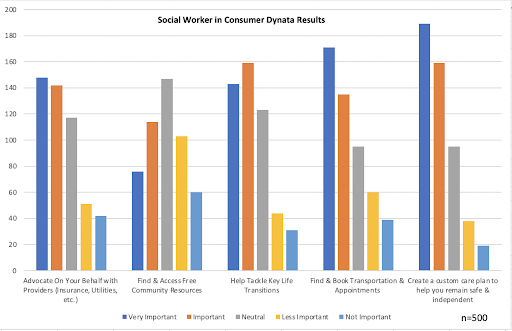

Results
Support me to remain safe and independent
- 68% of the survey participants expressed a strong sentiment regarding the importance of social workers' assistance in maintaining their safety and independence
- 46% of particpants have joined personalized programs created by nutritionists, dieticians, personal trainers, mental health professionals in the past. 63% of participants indicated positive sentiments towards trying out a general well-being program guided by social workers in the future.
Assist me during key life transitions.
- 59% of the survey participants expressed a strong need for support during critical moments of change and adaptation.
Advocate on my behalf with providers
- 52% expressed a need for assistance when communicating with service providers or navigating healthcare entities, including insurance providers.
- 53% communicated with a primary care provider (PCP) more than twice a year to manage their chronic conditions.
Recommendation: Emphasize holistic health management and timely support to proactively address potential health concerns for seniors.
02
Personas
Providing focus & establishing empathy
Based on foundational and secondary research findings, we developed user personas that represent distinct archetypes of seniors and caregivers. These personas help us empathize with their unique circumstances, preferences, and attitudes toward healthcare management.
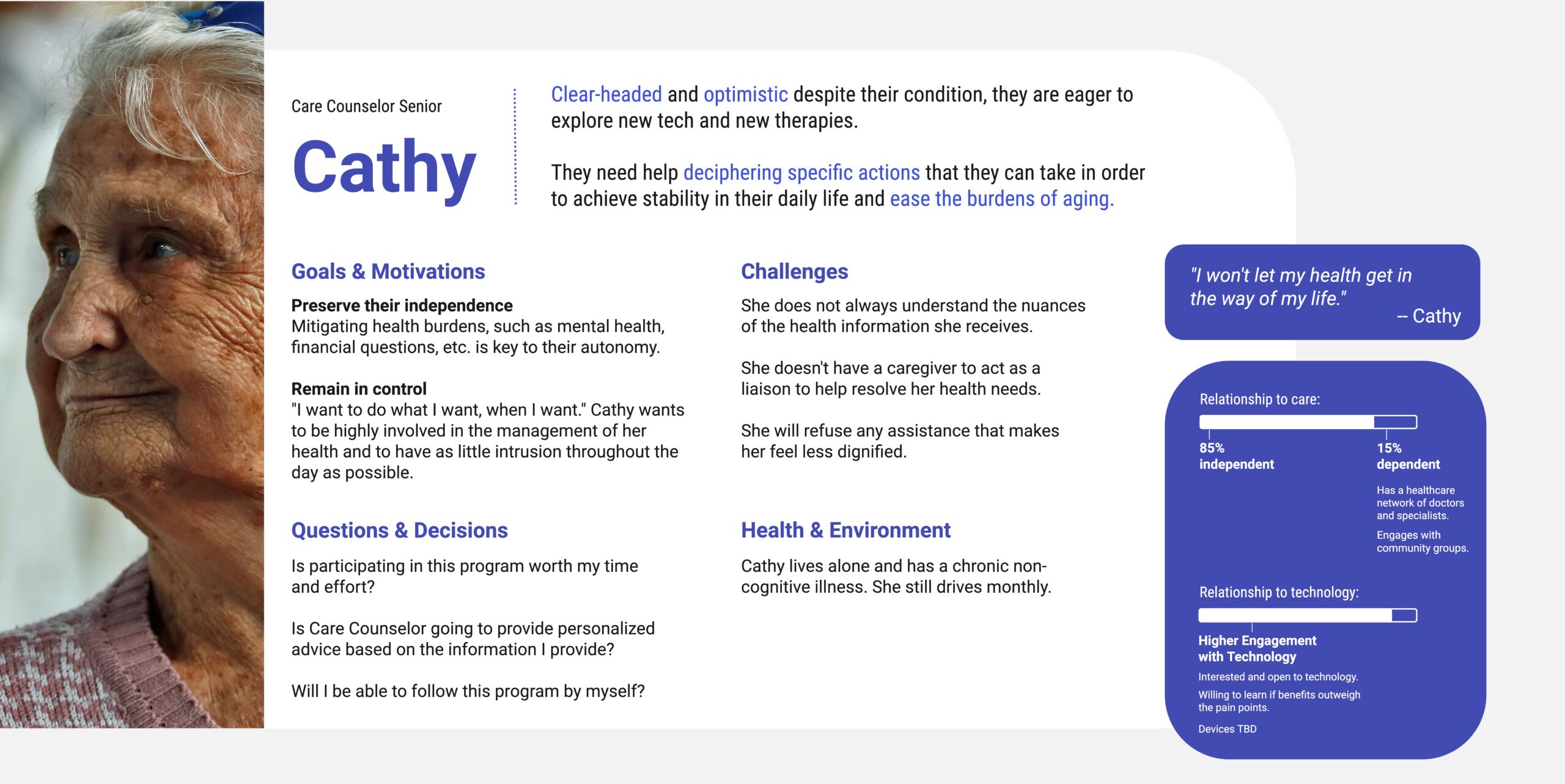

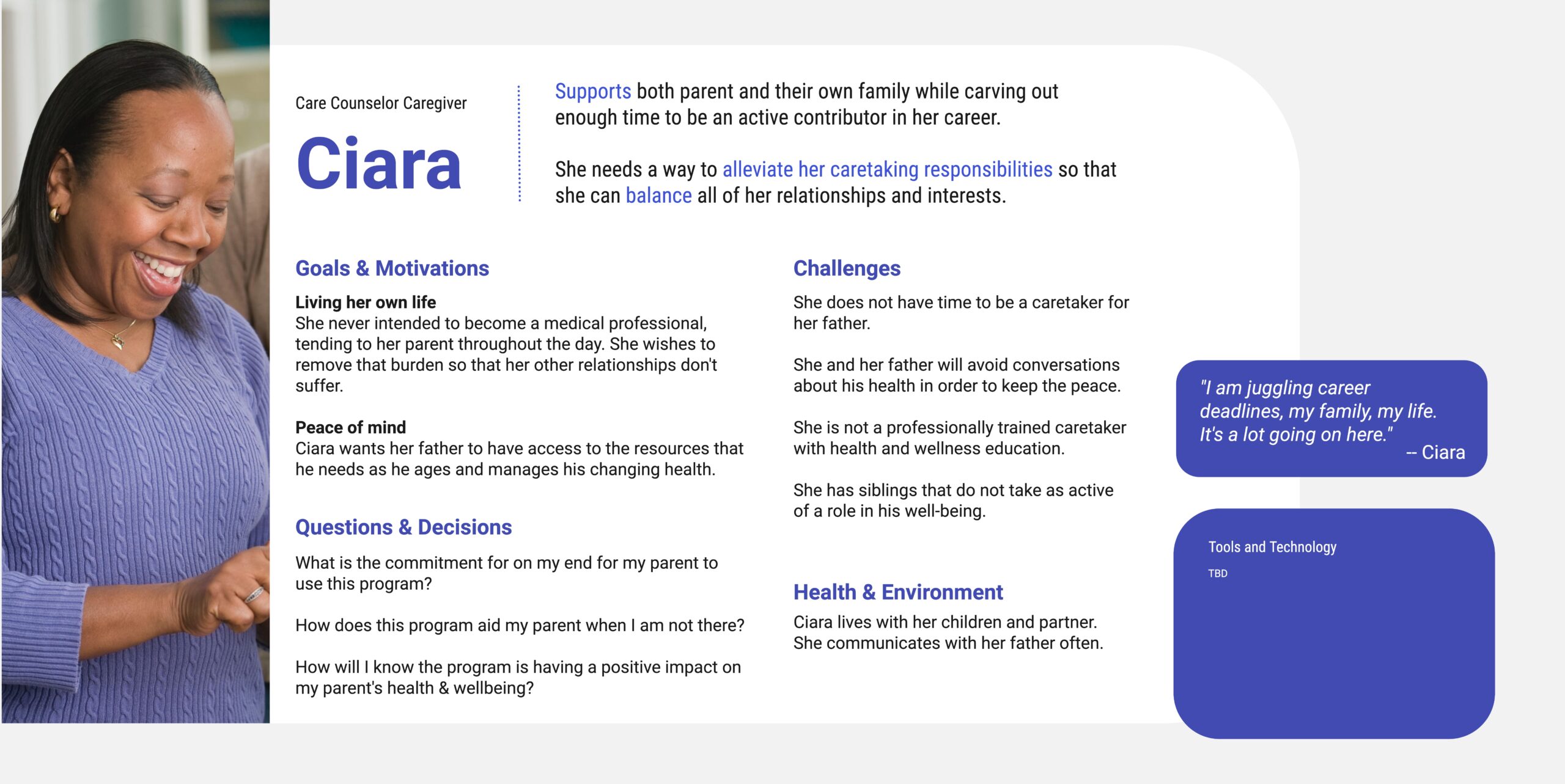

03
User Journey Map
Establishing a shared vision
We mapped out user journeys to visualize the various touchpoints and interactions seniors have with healthcare services. This provides a comprehensive view of the challenges they face and opportunities for intervention.
The Process
- Prompts active conversations
- Creates team alignment
- Establishes a shared vision
The Artifact
- Establishes a shared vision
- Uncovers pain points & opportunities
- Used for decision-making & prioritization
What can we do with our User Journey Map?
- Identify pain points & areas of opportunity
- Connect the outside journey to internal processes (perhaps with a service blueprint)
- Establish a product roadmap (including v1 requirements)
Create KPIs
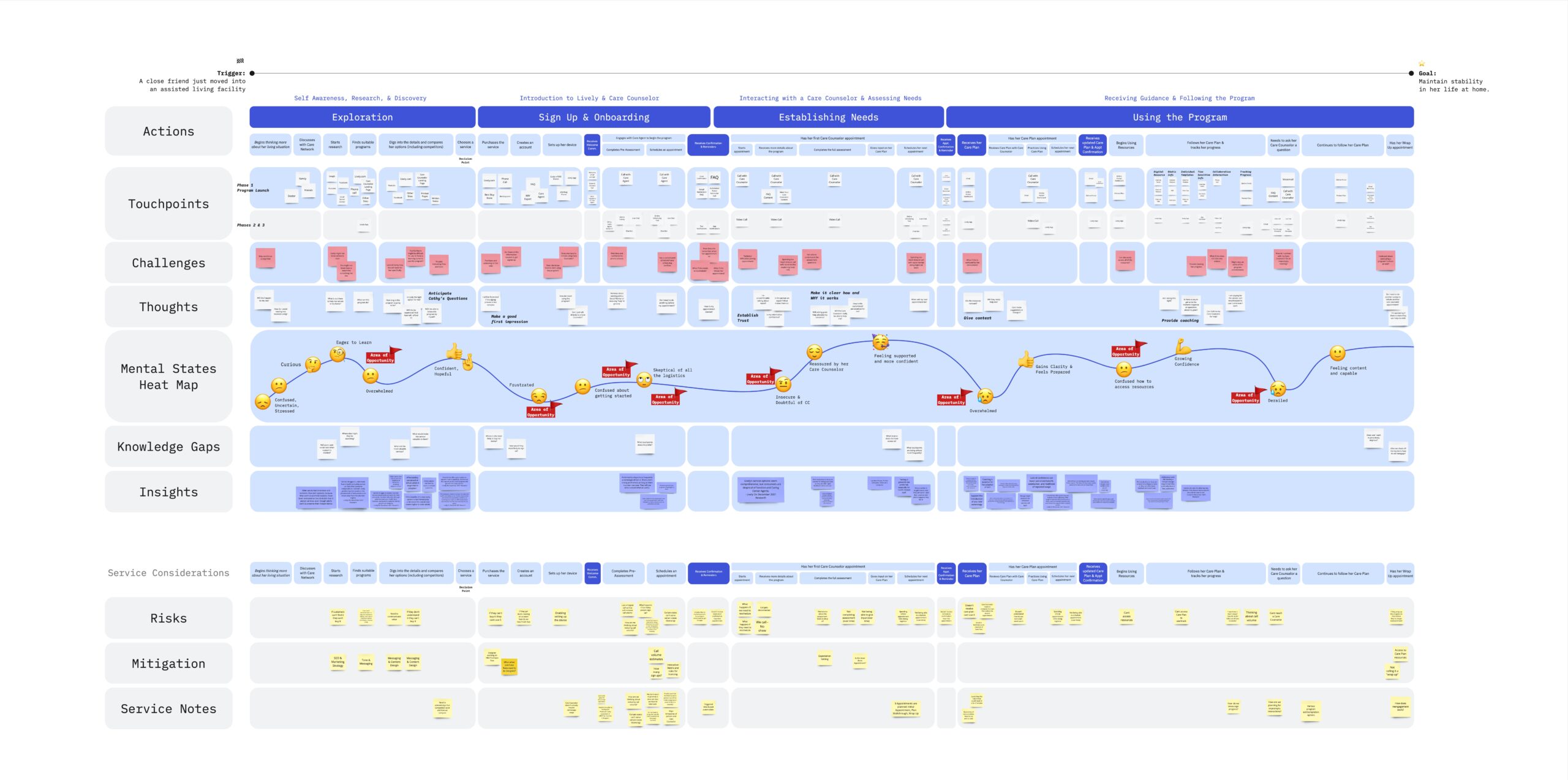

04
Context Builiding Using Principles of Behavioral Science
Intro
Drawing from behavioral science, we specified a behavior for change using the AACTT framework (Action, Actor, Context, Target, Time). Then we analyzed the determinants of behavior using the COM-B model (Capability, Opportunity, Motivation - Behaviour). Once we had a deeper understanding of what was driving the current behavior, we identified key principles to shape the design of the care plan using both the MINDSPACE and the Intervention Function framework.
AACTT Framework (Action, Actor, Context, Target, Time)
Action: Kathy needs to find ways to maintain her enthusiasm and commitment to follow through with the identified actions, even in the face of challenges or setbacks.
Actor: Kathy herself is the actor responsible
Context: The context is Kathy's everyday life, which includes her living situation, daily routines, access to resources, and the various challenges she encounters as she ages.
Target: The target is to achieve stability in Kathy's daily life and reduce the burdens of aging. This includes improving her overall well-being, health, and independence.
Time: The timeframe for both actions is ongoing and continuous.
COM-B model
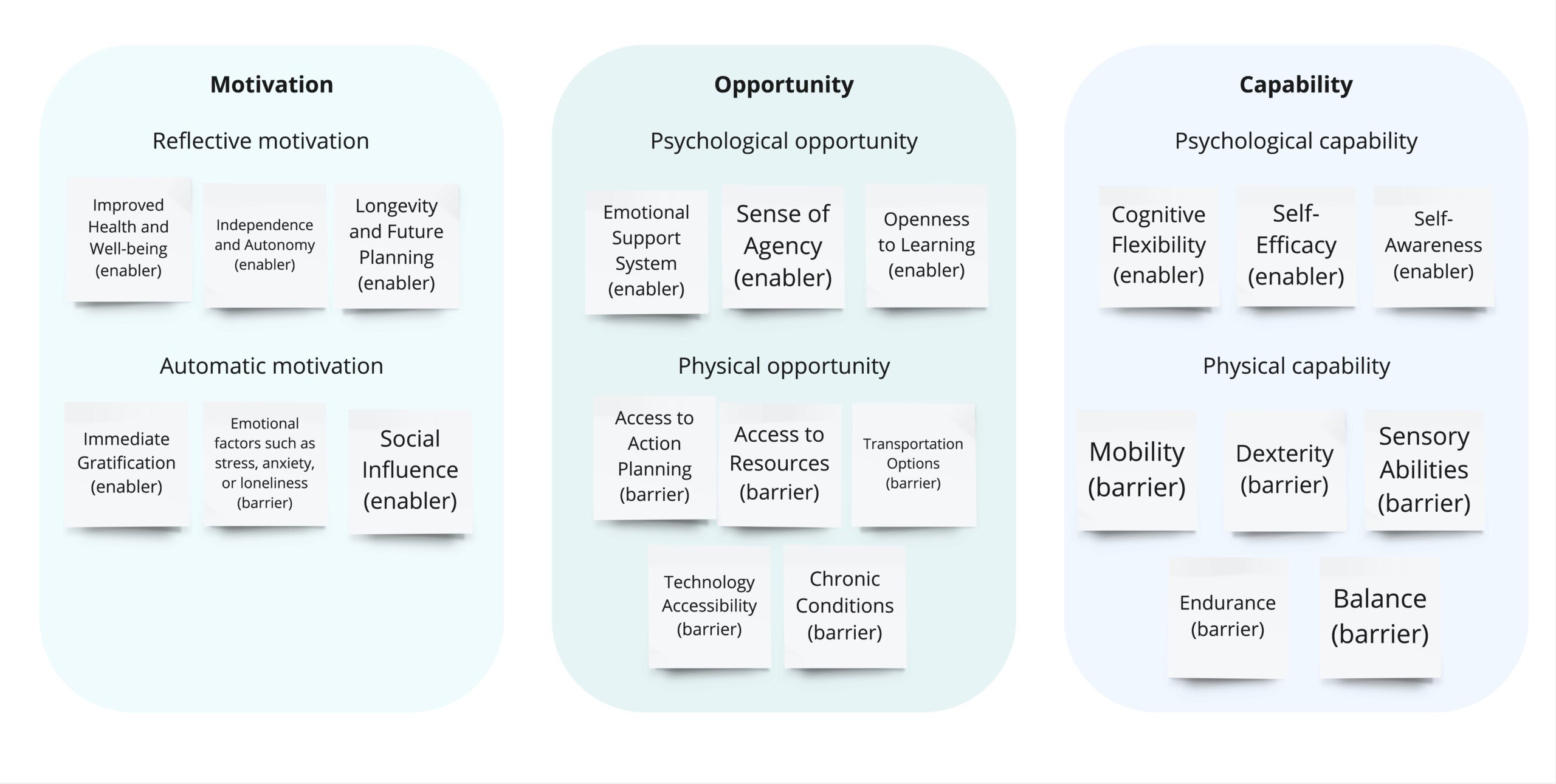

05
Defining the problem
Initial problem statement
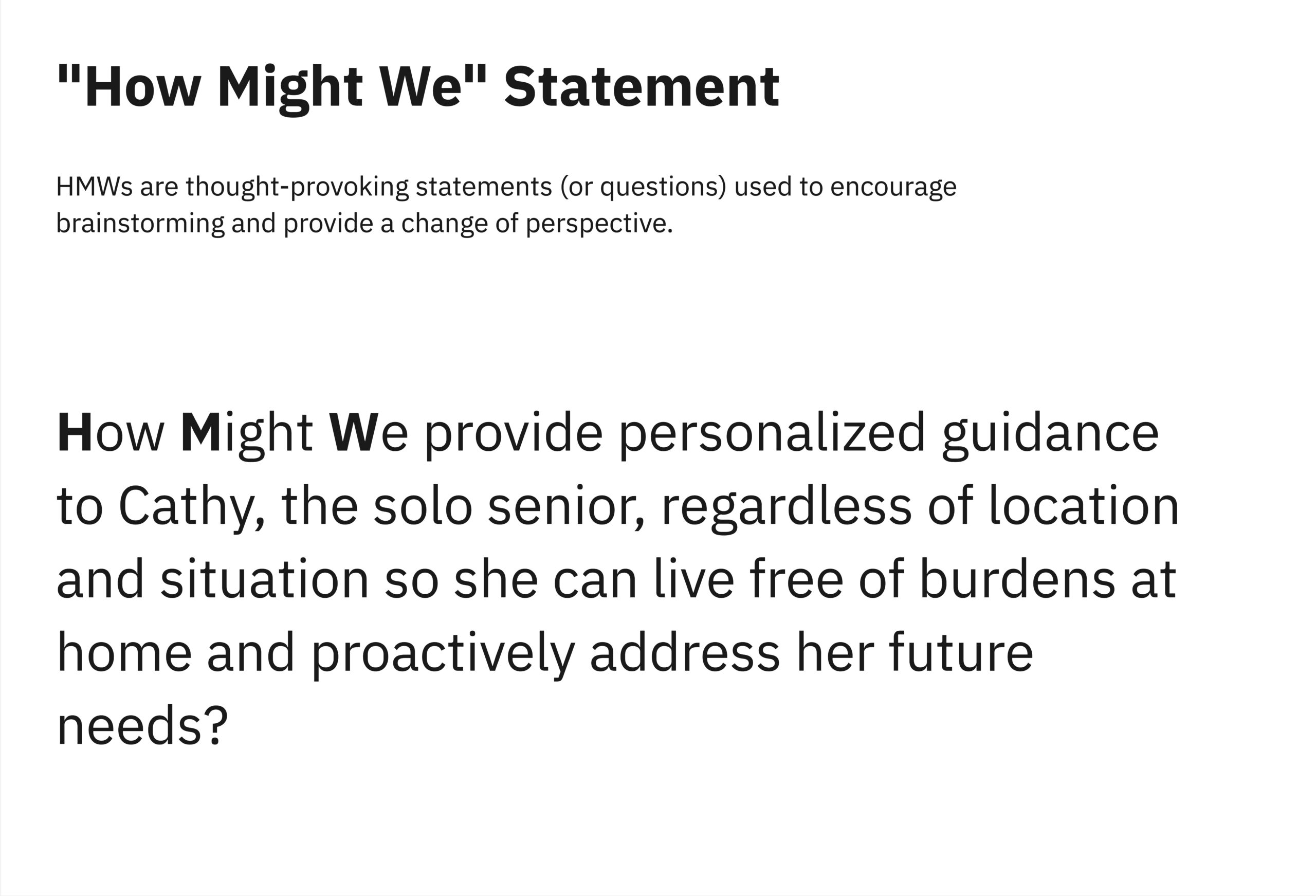

This initial problem statement was crafted before applying principles of behavioral science to analyze the issue. After implementing behavior principles and assessing enablers and barriers, I refined the problem statement through iteration.
Bridging the intention-behavior gap
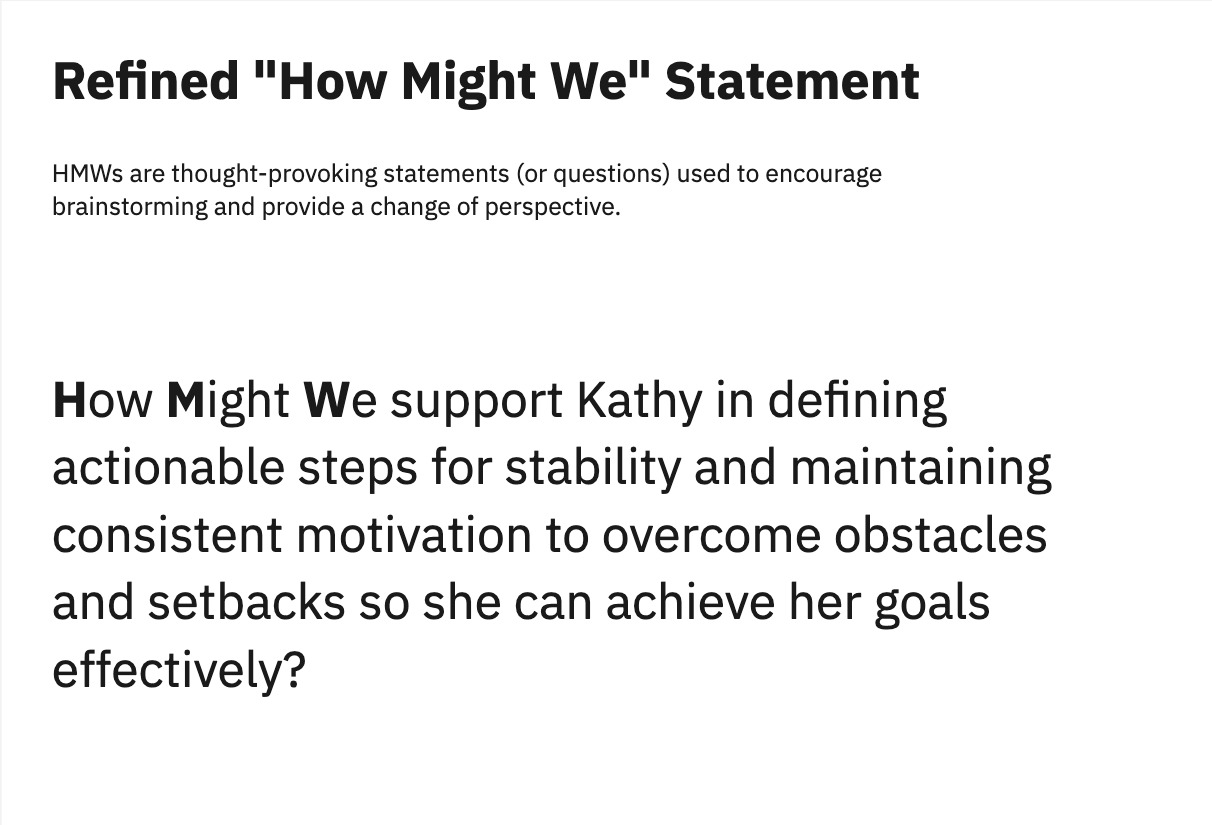

Narrowing it down a little more...
Utilizing the COM-B model, which examines Capability, Opportunity, and Motivation in behavior, I identified potential barriers for Kathy. Apart from barriers in both opportunities and capabilities, automatic motivations like emotional triggers may further hinder her progress, leading to feelings of stress or anxiety when striving to achieve goals independently.
Through literature review, a prominent theme that emerged was the difficulty patients faced in achieving goals independently. This can be attributed to the intention-behavior gap (Gollwitzer, 2009). According to the research, intention is only moderately predictive of behavior and accounts for a variance of approximately 3-28% (Webb and Sheeran 2006). In some cases, despite receiving persuasive information, intentions remained unchanged (Webb and Sheeran 2006).
Gollwitzer, P.M., Sheeran, P., Michalski, V. and Seifert, A.E. (2009). When Intentions Go Public. Psychological Science, 20(5), pp.612–618. doi:https://doi.org/10.1111/j.1467-9280.2009.02336.x.
Webb, T.L. and Sheeran, P. (2006). Does changing behavioral intentions engender behavior change? A meta-analysis of the experimental evidence. Psychological Bulletin, 132(2), pp.249–268. doi:https://doi.org/10.1037/0033-2909.132.2.249.
06
Strategies for Behavior Change Using the MINDSPACE and Intervention Functions Framework
Keeping the defined problem in mind, I utilized the MINDSPACE framework to create behavior change strategies. The MINDSPACE framework is a set of principles developed by the UK government's Behavioral Insights Team to influence behavior effectively. It stands for Messenger, Incentives, Norms, Defaults, Salience, Priming, Affect, Commitment, and Ego.
I've also considered the Intervention Functions and included them in the creation of behavior change strategies. The Intervention Functions inlcuding Education, Persuasion, Incentivisation, Coercion, Training, Restrictions, Environmental restructuring, Modelling, Enablement.
Motivation Strategies
Goal Setting and Action Planning
Guiding Kathy to set specific goals and creating action plans commits her to follow through with her desired actions.
- Intervention: Persuasion
- MINDSPACE: Commitment
Progress Tracking
Providing regular feedback and progress tracking keeps the importance of her efforts salient in her mind, reinforcing positive behavior.
- Intervention: Enablement
- MINDSPACE: Salience
Social Support Network
Building a social support network may involve some degree of persuasion to encourage Kathy to complete tasks like going on a 20 min walk every day.
- Intervention: Persuasion
- MINDSPACE: Norms
Opportunity Strategies
Access to Resources
By connecting Kathy with resources and making them easily accessible, these opportunities become more salient.
- Intervention: Enablement
- MINDSPACE: Salience
Sense of Autonomy
Kathy values her agency and dignity, and taking proactive steps to address her challenges aligns with her values of being independent.
- Intervention: Incentivization
- MINDSPACE: Ego
Capability Strategies
Education
Receiving guidance and collaborating with a care agent primes Kathy's knowledge and skills for deciphering specific actions and implementing them effectively.
- Intervention: Education
- MINDSPACE: Priming
07
Experience roadmaping & designing
Through deliberate decision making, We prioritized user needs, usability, and technical constraints while staying within budget and timeline.
- Some ideas might be so fundamental to the core user experience that they must be included in the short-term column.
- Other ideas may need to be scoped-down into more realistic mid-term and short-term experiences or enablements.
- Ideas that are not feasible in the short-term or that are not fundamental to the core user experience can stay in the long-term column.


07
The MVP
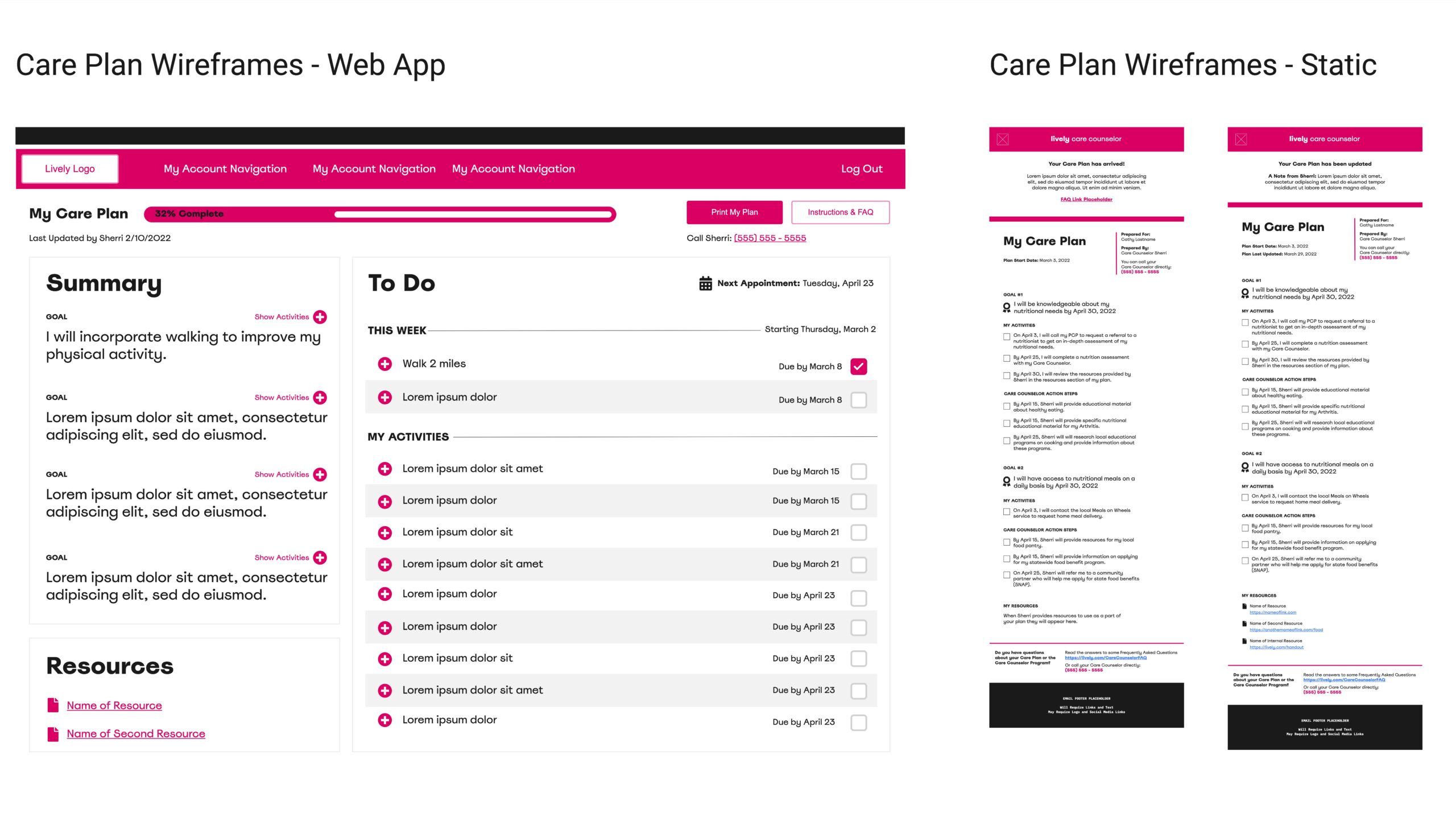

Informed by behavior change strategies, the initial design enabled Goal Setting and Action Planning, Progress Tracking, and Access to Resources. The Care Plan wireframes were crafted through a collaborative process, gathering requirements references and aligning teammates to craft a user-centric experience from start to finish. We gathered essential inputs from various sources, including:
- Job Stories: These are collaboratively generated by the team, highlighting user needs within the User Journey.
- Product Requirements: User Stories created by Product Management, referencing the Job Stories to align with user needs and goals.
- Valuable insights from dedicated Care Agents: they are expert social workers who understand the challenges seniors face. With their guidance, we've crafted Care Plan Objectives that cater to seniors' unique needs: Path to Wellness-Inspired, Customer Engagement-Driven UI, Addressing Non-Medical Determinants of Health.
Given the engineering constraints, the MVP of the Care Plan will be static, and delivery will take place via email. The Care Plan will be thoughtfully included either in the body of the email or as an easily accessible attachment. Although it may lack the full interactivity we envision, this solution ensures we deliver vital care information efficiently.
08
Evaluative Research
Research Objective
To understand how GenA customers currently utilize technology to receive and consume content.
Research Questions
- What are the primary purposes for which GenA customers use technology to consume content?
- What types of content do GenA customers commonly access through technology?
- How might GenA customers envision accessing instructions sent by their care advocate?
- Are GenA customers able to access documents/PDFs?
- Are there any barriers or challenges GenA customers face when using technology?
- Which devices or platforms do GenA customers prefer for content consumption?
- How frequently do GenA customers use technology to access content?
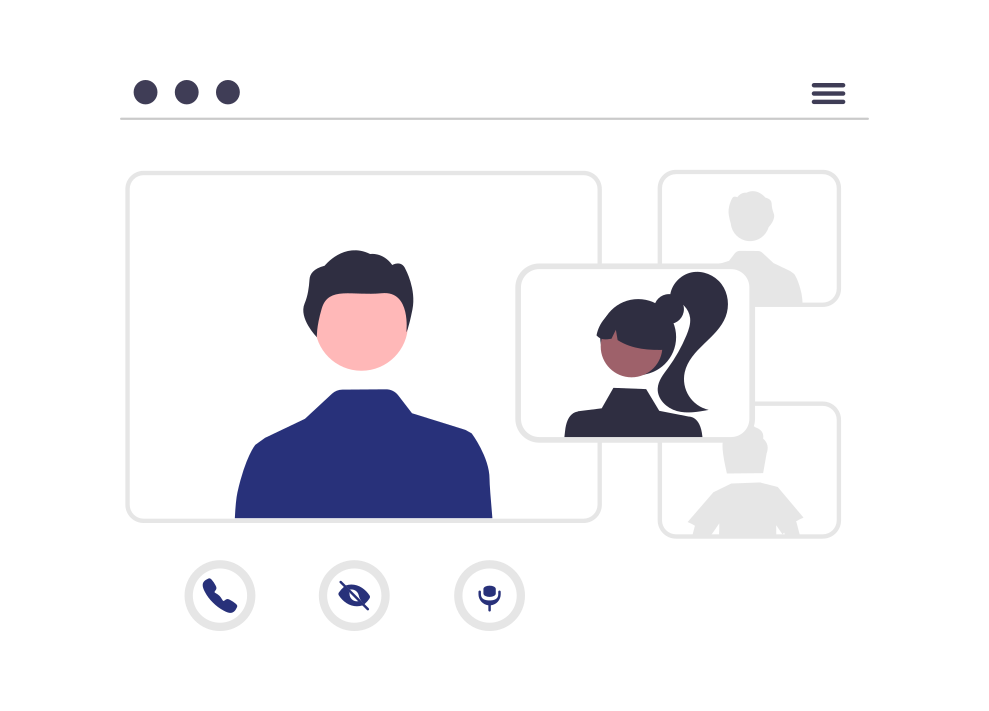

Research Method
n=87; Conducted 87 one-on-one 15-minute interview sessions over the phone.
- Age: 63-74
- Geographical Location:
› West Coast: 10, 11%
› Midwest: 34, 39%
› Northeast: 17, 20%
› South: 26, 30%
• Mix of device and technology usage
• Mix of experience with participating in self-help programs


Most participants can navigate technology comfortably and frequently use both laptops and phones.
- All participants indicated they owned or interacted with some form of technology for daily usage in their lives with most participants also owning a laptop or PC.
- When asked about the specific function of each device, the average participant response indicated that laptops and PC were used for more in-depth tasks (such as accounting or documentation) while phone and tablets were used for light tasks or activities (such as internet browsing, social media, entertainment, etc.).
Recommendation: By facilitating content discovery and fostering social connections, technology can a pivotal role in enhancing their overall experience and satisfaction. Technology can also significantly impact the way they stay engaged with their interests and hobbies.
Results
"I'd like to have one person that I can go to for every aspect of my health. It's better than getting pieces of
information here and there."
- 46% of particpants have joined personalized programs created by nutritionists, dieticians, personal trainers, mental health professionals in the past. 63% of participants indicated positive sentiments towards trying out a general well-being program guided by social workers in the future.
Recommendation: Emphasize holistic health management and timely support to proactively address potential health concerns for seniors.
Most participants
indicated that they would
prefer an email for receiving info.
- When asked how they’d like to potentially receive instructions from the Care Counselor program, 75% of participants indicated that they would prefer an email.
Recommendation: Prioritize utilizing emails as the primary communication channel to deliver information and updates to users. Implementing more robust technology platforms should be only considered when new features warrant such advancements, such as when the functionalities significantly benefit from interactivity or personalized experiences for the users.
09
Future Considerations Wireframes


Integration with the existing Lively App
As we explore future considerations for enhancing the Lively™ Service Care Advocate, a compelling opportunity lies in the seamless integration with the existing Lively App. The Lively App connects the Lively Wearables to Android smartphone which gives users access to the Lively™ Urgent Response Team.
With this integration, seniors will benefit from the synergy of features, such as centralized health information, personalized care plans, and direct access to their dedicated Care Agent. By having all relevant health and wellness resources within the familiar Lively App, we aim to reduce cognitive load and streamline their interactions, making it easier for seniors to manage their well-being effectively.
Curated for You: Goal-oriented, personalized recommendations
Based on the goal and activities co-created by the senior and their care advocate as well as the resources provided by care advocates, users would receive personalized recommendations.
Leveraging the power of a Machine Learning model, Care Advocate will deliver curated content directly aligned with each user's unique objectives and preferences. By providing personalized resources, such as articles, videos, or interactive tools, users can proactively engage with content that resonates with their individual wellness journey.
Guided by the "education" principle of the behavior change strategy, this approach not only enhances user engagement but also effectively bridges the intention-behavior gap by empowering seniors to make meaningful progress towards their health and well-being goals.
Friends' activities: Celebrating Community & Progress
By incorporating a social element, users can celebrate each other's progress, providing a positive and motivating environment.
This aligns with our the behavior change strategy Social Support network, Emphasizing the significance of persuation and norms in staying motivated and consistently achieving health and wellness goals.